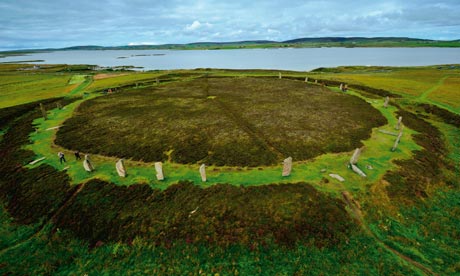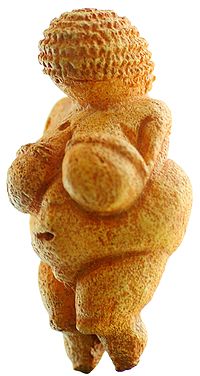
Circle of life: the Ring of Brodgar – a stone circle, or henge – is a World Heritage Site. Photograph: Adam Stanford
Posted on 10/07/2012 2:56:45 AM PDT by Renfield
Drive west from Orkney's capital, Kirkwall, and then head north on the narrow B9055 and you will reach a single stone monolith that guards the entrance to a spit of land known as the Ness of Brodgar. The promontory separates the island's two largest bodies of freshwater, the Loch of Stenness and the Loch of Harray. At their furthest edges, the lochs' peaty brown water laps against fields and hills that form a natural amphitheatre; a landscape peppered with giant rings of stone, chambered cairns, ancient villages and other archaeological riches.
This is the heartland of the Neolithic North, a bleak, mysterious place that has made Orkney a magnet for archaeologists, historians and other researchers. For decades they have tramped the island measuring and ex- cavating its great Stone Age sites. The land was surveyed, mapped and known until a recent chance discovery revealed that for all their attention, scientists had completely overlooked a Neolithic treasure that utterly eclipses all others on Orkney – and in the rest of Europe....
(Excerpt) Read more at guardian.co.uk ...

Circle of life: the Ring of Brodgar – a stone circle, or henge – is a World Heritage Site. Photograph: Adam Stanford
Ping
Neat. If I’m not mistaken, that’s (the Orkney Islands) the path my dad’s ancestors (the Gunns) took, coming from Norway to Scotland. Thank you.
Fascinating. I wish scientists would stop assigning motives to early man which are based on modern behavior.
i.e. ‘animal sacrifice’ rather than ‘meal time’.
Perhaps early man discovered singing and encouraged group chorus.
We should stop projecting our accomplishments on early man and take a childlike logic and practicality to people who lived only 30 years and were likely impatient to create a functioning, comfortable life for themselves and their progeny. They may have experienced ‘wonder’ at the earth and sky, but not a formal ‘religion’ of a creator or astral Gods.
Like the Venus of Willendorf, long labeled an idol – the mother goddess. Everything found had to have a religious connection. Now many think of it as nothing more than ancient porn.
Neolithic blow up doll.....?
Thank you for understanding my comment.
Just pondering - when future generations find an abandoned house with all the fixtures trashed and graffiti on the walls; what will they conclude?
The inhabitants sacrificed the fridge and wrote prayers to Gods on the walls?
Google “motel of the mysteries”!
Why not, “but not a formal ‘religion’ of a creator or astral Gods.”, as you say?
This area predates the Romans and the Greeks, so surely there were no ‘Christians’ at the time these folks lived.
This newest found henge has stones aligned, and I am sure that they will be found to be mapped out, astronomically. How did that happen?
In the middle of Christianized Europe, on the banks of the river Danube, there have been found hand carved, hand sized goddess figures. How did that happen?
Reading through the history of mankind, and finding any ‘defined as horrifying’ instances of anything smattering other than ‘Christian’, has always puzzled me. They are our distant ancestors. They were born, lived, and died, as we do today, but with little ‘left to the ages’, unlike us, today. It is a wonder, that in that harsh environment, their homes still stand! It is a wonder how they were constructed. Who were they? What were their ideas on life? On death? What were their tribal mores? Lastly, in close quarters, where was the proverbial ‘village rock’? There might be something we could learn from all of this.
Lastly, as a thought, in an era where everything is going more electronic than we ‘first-generation geeks’ ever thought, always remember, there is no power electric necessary, to pick up a pen, and put thoughts to paper, which will outlast any electrical fizzlement inside any electronic gadget.
These date back a couple of thousand years before the Orkney stones (5300 to 6500 years ago), but by that time our earlier pre-Celtic ancestors were busy little beavers whacking down dolmens jus' all over the place.
These structures have nothing to do with the Picts and other Indo-Europeans from the more barbarous inland ~ all of them were accessible from the sea which, in those days, was the international interstate highway system.
600 dead cows suggests some sort of OX ROAST ~ and today we need a special reason for that sort of thing.
I’ve often thought of that. Hopefully a thousand years in the future archaeologists will be more open minded.
In defense of some current and past archaeologists most were very religious, many were clerics. Their paradigm was religion based so anything that took time and effort to make was deemed of religious significance unless it had an obvious secular use.
More like a Playboy magazine.
Love the bloodless terminology.
The American Indians and Australian aborigines were just "replaced." Though I suspect he meant "displaced."
Nothing to see here, move along.
|
|
|
| GGG managers are SunkenCiv, StayAt HomeMother & Ernest_at_the_Beach | |

|
|
Thanks Renfield. |
|
|
|
|


I think they're still arguing about wheather thats plaided hair or a knitted cap on her head too.
A better title for the article might be:
Why IS Orkney the Center of Neolithic Britain?
It looks to me like these folk just kept traveling until they came to the outermost edge of the end of nowhere—and then settled down by that peaty ness to grow some grain and think about why they were there.
Somebody dropped some grain in that peaty water and and thus they invented usquebaugh, the Water of Life.
Then somebody said,”This stuff is so good it must be from the gods. Let us build a temple to celebrate the “Water of Life” where we can get out of this miserable weather.”
And so for millenniums, the Orkneyians lived there, drunk and happy.
And there, my friends, is the real story about this archeological find.
:’)
Disclaimer: Opinions posted on Free Republic are those of the individual posters and do not necessarily represent the opinion of Free Republic or its management. All materials posted herein are protected by copyright law and the exemption for fair use of copyrighted works.